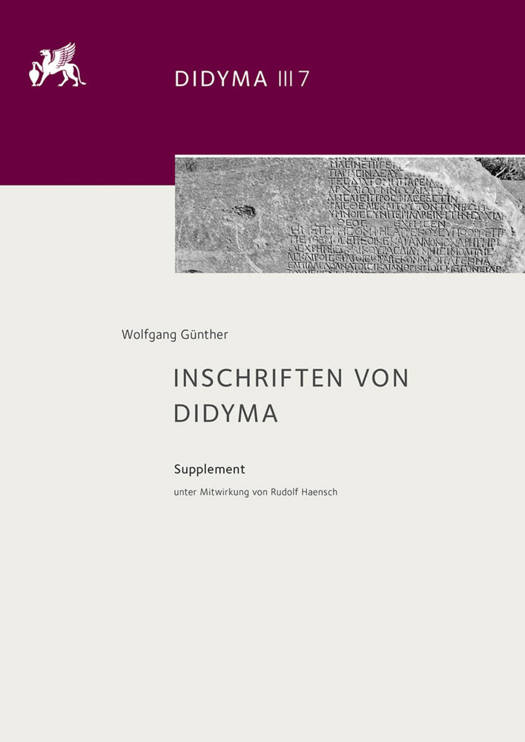
- Retrait en 2 heures
- Assortiment impressionnant
- Paiement sécurisé
- Toujours un magasin près de chez vous
- Retrait gratuit dans votre magasin Club
- 7.000.0000 titres dans notre catalogue
- Payer en toute sécurité
- Toujours un magasin près de chez vous
Inschriften Von Didyma
Supplement Unter Mitwirkung Von Rudolf Haensch
Wolfgang Gunther, Rudolf Haensch
103,45 €
+ 206 points
Description
English summary: This volume presents some 300 inscriptions, some of which are inedita from the Prussian excavations carried out until 1925, but the vast majority of which are new finds from the excavation activities resumed since 1962. They essentially cover a period of one millennium, from the 6th century BC to the 6th century AD, interrupted by a gap of about 170 years that occurred after the destruction of the sanctuary in the Ionian Revolt of 494 BC until its renaissance in the period of Alexander the Great. The new material, which documents in particular the Hellenistic era and the Roman imperial period, is not only a quantitative but also a qualitative addition to the Didyma inscriptions already recorded in the corpus by Albert Rehm from 1958. For example, the building reports contain new, detailed information for architectural research about the status of work on the temple of Apollo in the early 2nd century BC; the oracle inscriptions provide information for religious history about the increasing tendency of the sanctuary to become a Pantheon and a home for other cults as well. Finally, the numerous monuments erected by the representatives of the Apollo and Artemis cults, the Prophets and Hydrophors, as self-testimonies, give a contoured picture of the Milesian elite and its network. At the end of the long tradition and the drying up of the epigraphic tradition, there is a legal document from the time of Iustinian, which in its unique preservation and visualisation of writing can virtually be considered the queen of late antique epigraphy. German description: In diesem Band werden rund 300 Inschriften vorgelegt, die teils Inedita der bis 1925 durchgefuhrten preussischen Ausgrabungen, zum weitaus grosseren Teil aber Neufunde der seit 1962 wiederaufgenommenen Grabungsaktivitaten sind. Sie umfassen im Wesentlichen einen Zeitraum von einem Jahrtausend, vom 6. Jh. v. Chr. bis zum 6. Jh. n. Chr. (unterbrochen durch eine Lucke von ca. 170 Jahren, die nach der Zerstorung des Heiligtums im Ionischen Aufstand 494 v. Chr. bis zu seiner Renaissance in der Alexanderzeit eintrat). Das neue, insbesondere die hellenistische Epoche und die romische Kaiserzeit dokumentierende Material ist nicht nur ein quantitativer, sondern auch qualitativer Zuwachs zu den bislang schon im Corpus von Albert Rehm (1958) erfassten Didyma-Inschriften. So enthalten die Bauberichte fur die Bauforschung neue, detaillierte Informationen uber den Stand der Arbeiten am Apollontempel im fruhen 2. Jh. v. Chr.; die Orakelinschriften geben fur die Religionsgeschichte Hinweise uber die zunehmende Tendenz des Heiligtums, als Heimstatte auch anderer Kulte zu einem Pantheon zu werden. Die zahlreichen Denkmaler schliesslich, welche die Reprasentanten des Apollon- und Artemiskults, die Propheten und Hydrophoren, als Selbstzeugnisse errichteten, zeichnen ein konturiertes Bild der milesischen Elite und ihrer Vernetzung. Am Ende der langen Tradition und dem Versiegen der epigraphischen Uberlieferung steht eine Rechtsurkunde aus der Zeit Iustinians, die in ihrer einzigartigen Erhaltung und Schriftvisualisierung geradezu als Konigin der spatantiken Epigraphik gelten kann.
Spécifications
Parties prenantes
- Auteur(s) :
- Editeur:
Contenu
- Nombre de pages :
- 308
- Langue:
- Allemand
- Collection :
- Tome:
- n° 7
Caractéristiques
- EAN:
- 9783752007237
- Date de parution :
- 05-12-23
- Format:
- Livre relié
- Format numérique:
- Genaaid
- Dimensions :
- 220 mm x 25 mm
- Poids :
- 358 g

Seulement chez Librairie Club
+ 206 points sur votre carte client de Librairie Club
Les avis
Nous publions uniquement les avis qui respectent les conditions requises. Consultez nos conditions pour les avis.






